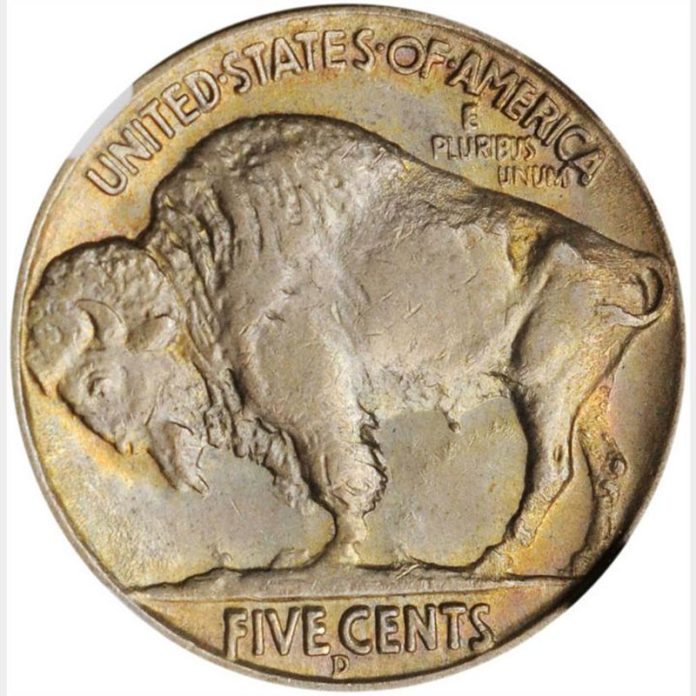
Economic forecasts for 2024 point to an easing of inflationary tensions, a weakening global economy and volatility in precious metals. Conditions in 2024 could lead to a coin market with many moving parts. Collectors completing date sets of coins will put upward price pressure on key-date coins. Ultra-rare copper coins can be expected to return to favor if the price of gold bullion shows transitory softness, but the spotlight will still be on the earliest and rarest classic gold coins. The four Heritage Auctions sales of the Harry W. Bass, Jr. Core Collection established a solid collector base and asset class for early gold coins; approximately $83.7 million in total. Coins should be verified as to their authenticity and grade on the one through 70 scale by CAC Grading, the Numismatic Guaranty Company or Professional Coin Grading Service.
1. Earliest $5 (Half Eagle) Gold Pieces in About Uncirculated and Mint State Conditions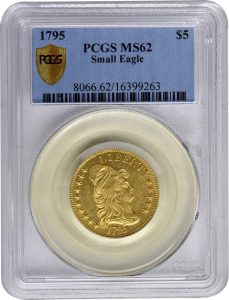
The eagle ($10 gold piece) was produced from 1795 to 1804 and came with a Capped Bust portrait of Miss Liberty. The half eagle ($5 gold piece) was issued almost every year from 1795, but the quarter eagle ($2.50 gold piece) appeared somewhat sporadically – and not at all from 1809 through 1820. Both went through a series of design changes, evolving from the early Capped Bust facing right to a different Capped Bust facing left, then to a Capped Head version and finally to the so-called Classic Head.
The Capped Bust Portrait facing right half eagles were struck from 1795 to 1807, with a small eagle gracing the reverse of some of the coins from 1795 to 1798. Many start by buying a single coin, but soon decide to assemble a set from 1795 to 1807. The early quarter eagles and eagles from this time can be much more expensive, and that deters people from assembling the full set.
Coin prices for early half eagles that are lightly circulated start at about $15,000. Insatiable demand exists for the 1798 half eagle with the small eagle reverse. PCGS lists the AU-55 price for this coin at $1.5 million.
The 1795 half eagle with the small eagle on the reverse is perennially popular, with feverish demand in all grades.
2. Type II and III Liberty Head Double Eagles Graded Mint State 60 Through 63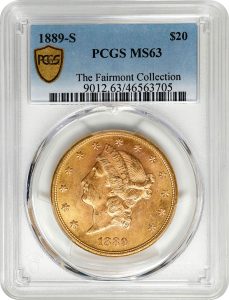
The Saint-Gaudens double eagle ($20 gold piece) is a superstar of U.S. gold coinage and is hailed as America’s most beautiful coin. Earlier coins are not as glitzy but they’re often more rare and sometimes priced close to the melt value of the gold they contain.
The double eagle, or $20 gold piece, came in 1849 as a direct result of the California Gold Rush. Congress authorized two new gold coins—this nearly one-ounce heavyweight and the tiny gold dollar—to help soak up the excess gold supply. The basic design of the Liberty double eagle remained much the same through run, but collectors recognize three distinct types. The original version gave way to Type II in 1866, when the motto IN GOD WE TRUST was added to the reverse. Then, in 1877, Type III came about when the statement of value was changed from the shorthand TWENTY D. to TWENTY DOLLARS.
Michael R. Fuljenz, author of award-winning books on the subject, reports that Type II and III examples in mint condition are considerably rarer than Saints in mint condition and original bags of uncirculated Saints exist in greater quantity in Europe than bags of mint state Liberties.
With gold at $1,930 per ounce, a common date Type III Liberty Head double eagle contains 0.9675 of an ounce of gold and retails for $2,100 in MS-60; $2,150 in MS-61; $2,200 in MS-62; and $2,300 in MS-63. Type II is rarer and, thus, more expensive, but sometimes carries small premiums over the melt value of the gold. Scarcer dates command premiums. An 1889-S Liberty Head double eagle graded MS-63 is worth $3,900.
3. Scarce-Date Silver Dollars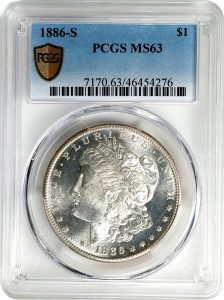
The Morgan silver dollars reign as kings of the hill because they are large, bulky coins with high precious metal content, they’re old and many are extremely well preserved since millions never left bank and government vaults.
Certain common-date Morgan dollars – the 1880-S and 1881-S, for example – exist in large quantities. You should concentrate instead on coins with lower mintages, even though their condition might be a bit less spectacular. They needn’t be rare – only scarce.
The 1886-S Morgan dollar and 1928 Peace dollar are two good examples. Both are available in MS-63 for about $1,000 each. These coins have seen consistent demand, yet they’re difficult to promote by mass marketers. This makes them less prone to volatility.
4. Mercury Dimes from the 1940s Graded Mint State-67 with Full Bands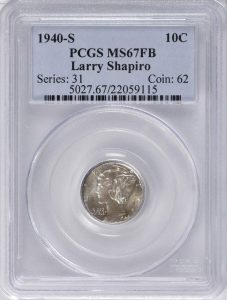
Collectors have observed that Winged Liberty (or “Mercury”) dimes have weakness, as a rule, in portions of the fasces on the reverse. This device – a symbol of authority in Roman times – consists of a bundle of rods bound around an ax, and by rights, there should be a separation in the bands that bind the bundle. Only the sharpest specimens possess this separation, so “full-band” Mercury dimes are scarce and worth a premium.
Some MS-67 examples with full bands can command outrageous prices, but it can be fun to assemble partial sets with coins costing $200 apiece or so. If you handpick coins with magnificent, original and colorful toning in the $200 apiece range, you can sometimes resell them at auction for a substantial profit.
5. 1909-S Lincoln Cent Graded Extremely Fine or Better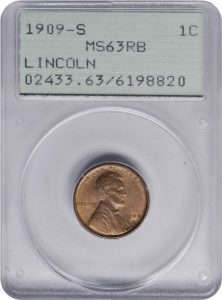
Focus on the very first Lincoln cents tends to be on those bearing the letters “VDB,” the coin designer’s initials for Victor David Brenner. They are at the base of the reverse as an artistic signature. Brenner’s three initials seemed to jump right off the coin prompting public protest and leading to their removal.
The San Francisco Mint had struck only 484,000 Lincoln cents before the initials were removed. The 1909-S VDB cent turned out to be the lowest-mintage coin in the whole Lincoln series, not counting errors and varieties. The West Coast Mint went on to produce 1,825,000 cents without the designer’s initials in 1909. You can expect to pay about $200 or so for a 1909-S cent graded Extremely Fine 45, and several times as much for one that is Mint State-63, but this is a scarce issue in a highly popular series.
6. Franklin Half Dollard Graded Mint State-66 or Higher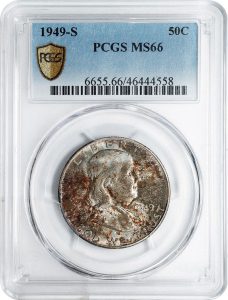
Following the assassination of President John F. Kennedy, Congress stopped production, which began in 1948, of the Franklin half dollar. This was a premature death as regular-issue U.S. coins generally can’t be replaced until they have been minted for at least 25 years.
There are no major rarities in the Franklin half-dollar series. The lowest-mintage issues, the Philadelphia halves of 1953 and 1955, were minted in numbers approaching three million. However, specialists have found that many Franklin halves are hard to find.
Subtle details are missing from most of these coins, even in mint condition; few, for example, display full lines on the bell. Franklin half dollars are common in grades of Mint State-63 and below; in higher grades, they command substantial premiums. Based on their scarcity, they’re well worth it. Prices sometimes reach thousands of dollars depending on specific coins. The examples you can acquire for a few hundred dollars apiece are keepers.
7. Isabella Quarter Graded Mint State-65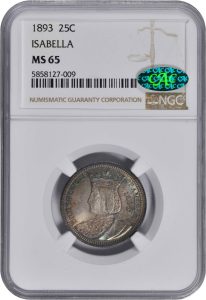
The Columbian Exposition on the shore of Lake Michigan ended up costing some $30 million – more than $1 for each of the 28 million visitors it attracted. To help defray these costs, the managers of the fair requested – and received – congressional authorization for special U.S. coins to sell as souvenirs to raise funds.
Initially, Congress authorized a half dollar bearing the likeness of Columbus. Some 2.5 million examples of this “Columbian half dollar” were minted in 1892 and again in 1893. Today they are considered quite common. A few months later, Congress authorized a 25-cent piece bearing the image of Spain’s Queen Isabella – who, with her husband Ferdinand, financed Columbus’ expeditions.
Just 40,000 examples of this “Isabella quarter” were minted, and more than 25,000 later were melted. Today, it is a scarce and coveted coin – and an example graded MS-65 will cost about $1,500, down from $4,000 some years back.
8. 1915 Panama-Pacific $50 Gold Piece, Either Octogonal or Round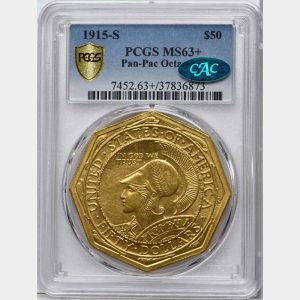
After overcoming formidable engineering and medical obstacles, American canal builders finished the massive Panama Canal project and the waterway opened in 1914.
The “Pan-Pac” coins included a silver half dollar, a gold dollar, a quarter eagle (or $2.50 gold piece) and two $50 gold pieces – the first U.S. coins ever issued in that denomination. The $50 coins were identical in design, both depicting the Greek goddess Minerva on the obverse and her symbol, the owl, on the reverse; one was round, however, while the other was octagonal.
After unsold specimens were melted, the net remaining figures were 685 octagonal pieces and 483 rounds. These coins are expensive, but they’re among the few vintage U.S. commemorative coins that have values that have withstood the test of time. A flashy MS-63 can be acquired for about $85,000.
9. 1793 Wreath Cents, Lightly Circulated and Better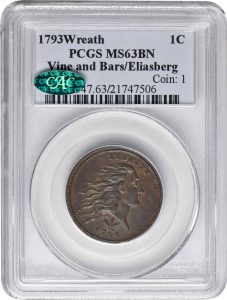
The first U.S. cents of 1793 are among the most intriguing. The Mint launched production by issuing a coin that came to be known as the “Chain cent.” The obverse bears a right-facing Liberty and the reverse shows the words ONE CENT within a chain of interlocking links. The coin encountered hostility from the outset. People saw the chain as a suggestion of slavery. The design was quickly replaced by a new one with a modified portrait of Liberty and a wreath on the reverse in place of the chain. Before the year was over, the Wreath cent was gone as well, giving way to a Liberty Cap design.
The Wreath cent is a rare coin of tremendous historical significance. The Mint produced only about 63,000 Wreath cents. A lightly circulated (AU-55) 1793 Wreath cent of the Vine and Bars variety is valued at $50,000, down in value over the last few years.
10. Gobrecht Dollar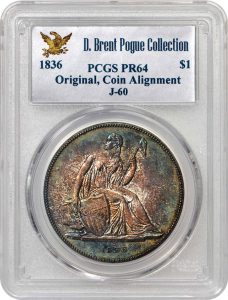
After completing production of 1803 silver dollars in the early part of 1804, the Mint suspended output of dollar coins leaving it on the sidelines for 30 years. Researchers now believe the rare silver dollars dated 1804 came into being in 1834 when the State Department had them struck as gifts for Asian monarchs.
Not long after the diplomatic episode that gave rise to those backdated 1804 silver dollars, the Mint began work on a different silver dollar with a fresh and dramatic new design. The job of preparing this coin was assigned to Christian Gobrecht, a gifted engraver and medalist who joined the Mint staff in 1835. Gobrecht was given designs by two talented artists, Thomas Sully and Titian Peale, and told to use them as the basis for a pair of coinage dies. The stunningly beautiful coin that resulted is known as the Gobrecht dollar. An 1836 Original Proof-64 example might be priced in the neighborhood of $80,000.
11. 1937-D Three-Legged Buffalo Nickel, All Grades
This fascinating mint-error coin came into being because a Mint workman failed to clean up properly after an accident.
A coin is produced when a planchet (or coin blank) is stamped simultaneously by two dies, one on the obverse or front and one on the reverse or back. Occasionally, the machinery jams and fails to feed a planchet into position. The dies then strike each other and each incurs damage from the other. These damaged dies are said to have “clash marks,” and standard procedure calls for stopping the press and removing them from service. In 1937, a worker at the Denver Mint decided to take a shortcut by pulling out an emery stick and grounding off the clash marks on a Buffalo nickel die. He may not have noticed it at first, but this removed not only the unwanted marks but also much of the foreleg of the bison on the die for the coin’s reverse. An EF-45 example is valued at about $1,000.
12. Seated Liberty Dollars Graded AU-50 to AU-55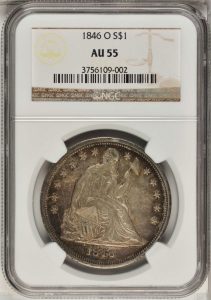
When Robert Maskell Patterson became Mint director in 1835, he wanted to upgrade U.S. coin designs to put them on a par with those of Europe. He oversaw the creation of a new silver dollar by engraver Christian Gobrecht. This coin, first struck in 1836, served as the prototype for the Seated Liberty coinage, which remained in use thereafter for more than half a century.
High-grade circulated examples – certified as, say, About Uncirculated-50 or AU-55 – can be had for about $1,200.
This article about coins to make money in 2024 previously appeared in COINage magazine. To subscribe click here. Article by Scott A. Travers. Photos Courtesy Stack’s Bowers Auctions.












